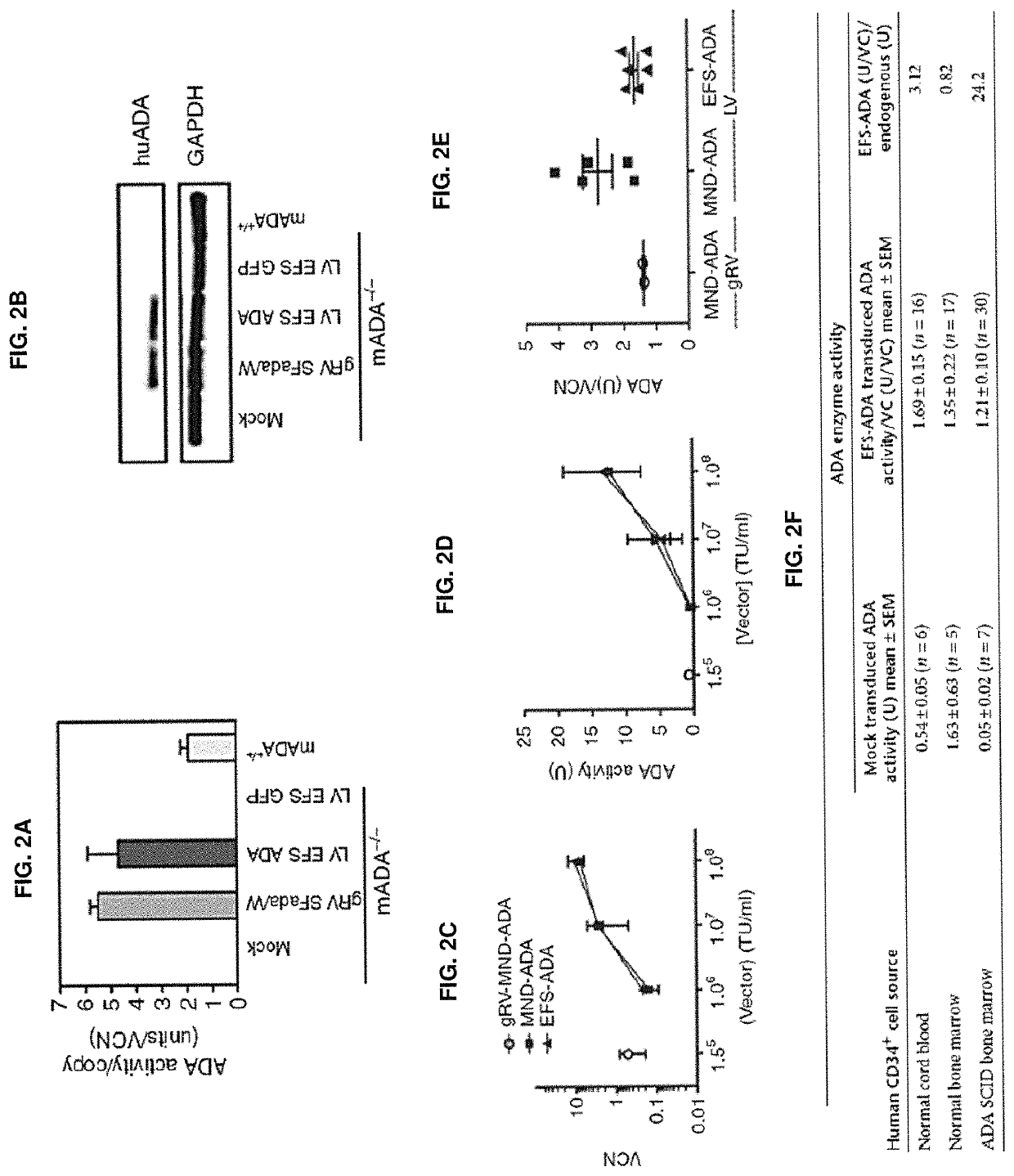Method for treating adenosine deaminase severe combined imunodeficiency
a combined immunodeficiency and adenosine deaminase technology, applied in the field of gene therapy, can solve the problems of poor long-term immune recovery, poor survival following hsct from matched unrelated donors (67%), mismatched unrelated donors (29%), or parental donors (43%), etc., to improve immune recovery, improve the ability of lv, and reduce the potential for insertional mutagenesis
- Summary
- Abstract
- Description
- Claims
- Application Information
AI Technical Summary
Benefits of technology
Problems solved by technology
Method used
Image
Examples
example 1
Comparison of Previously Used gRV Vectors with the Novel LV Vector
[0332]Vectors used are shown in FIGS. 1A and 1B. First, it was shown that LV ADA can efficiently transduce murine and human HSCs. Lineage depleted bone marrow cells (Lin−) isolated from ADA− / − mice (ADA− / − HSC) were isolated and transduced with viral vectors at a multiplicity of infection (MOI) of 20 under optimized protocols. Normalized enzymatic activity (ADA activity / vector copy) showed that LV EFS ADA had similar efficacy of transgene expression in murine ADA− / − HSCs compared with gRVSFada / W (FIG. 2A). Similar levels of ADA protein expression were detected in ADA− / − HSC by western blot analysis (FIG. 2B) and demonstrated that LV EFS ADA mediates efficient transduction and transgene expression in ADA− / − HSCs. LV EFS ADA was also compared to another gRV used previously in a clinical trial, gRV MND-ADA and an LV in which the MND LTR U3 enhancer / promoter controls ADA expression (LV MND ADA). Human cord blood CD34+ cel...
example 2
EFS-ADA Transduction of Normal and ADA-deficient Human Cord Blood and Bone Marrow CD34+ Cells Analysed In Vitro and Vivo
[0335]To further evaluate LV EFS ADA and to gain insight into the effects of IL-3 on LV transduction of human HSC, we compared transduction and long-term engraftment of the CB CD34+ cells, with and without IL-3 included in the prestimulation and transduction media. CB HSC (n=2) were thawed, plated (500,000 cell / ml), and prestimulated for 20 hours in medium containing human stem cell factor, human FLT3-L and human TPO (S / F / T), with or without IL-3 (20 ng / ml). The prestimulated cells were transduced with LV EFS ADA (3.0×107 TU / ml) or mock transduced. To test the effects of IL-3 exposure on the engraftment of more primitive stem / progenitor cells, LV EFS ADA-transduced or mock-transduced CD34+ cells were xenotransplanted into Nod / SCID / γ C (NSG) primary and secondary mouse recipients. The VCN measured after 14-day short-term culture was two-fold higher with IL-3 (2.5±0....
example 3
Further Pre-clinical Data Including Expression of ADA from the EFS-ADA LV Construct
[0338]In initial experiments, we compared the ability of the EFS-ADA lentiviral vector to express ADA in comparison to the current clinical grade γ-retroviral vector (Sfada / W). Following transduction of 3 different cell lines, ADA expression following transduction of cells with the EFS-ADA lentiviral vector (normalised for vector copy number) was either equivalent to or superior than the expression seen in cells transduced with the Sfada / W vector. This included an EBV transformed LCL from a patient with ADA deficiency (FIGS. 8A and 8B). Total ADA activity is shown in FIG. 8A and activity normalised for vector copy number is shown in FIG. 8B.
[0339]In further studies compared the EFS-ADA lentiviral vector with a similar lentiviral vector in which the ADA gene was transcribed by an internal PGK promoter. A number of different cell lines were transduced including ADA-ve LCLs, primary T cells from a normal...
PUM
| Property | Measurement | Unit |
|---|---|---|
| temperatures | aaaaa | aaaaa |
| temperature | aaaaa | aaaaa |
| size | aaaaa | aaaaa |
Abstract
Description
Claims
Application Information
 Login to View More
Login to View More - R&D
- Intellectual Property
- Life Sciences
- Materials
- Tech Scout
- Unparalleled Data Quality
- Higher Quality Content
- 60% Fewer Hallucinations
Browse by: Latest US Patents, China's latest patents, Technical Efficacy Thesaurus, Application Domain, Technology Topic, Popular Technical Reports.
© 2025 PatSnap. All rights reserved.Legal|Privacy policy|Modern Slavery Act Transparency Statement|Sitemap|About US| Contact US: help@patsnap.com



